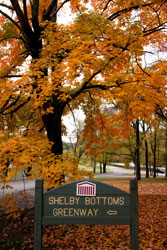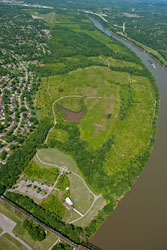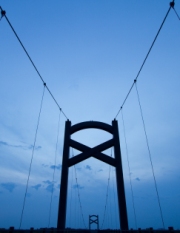The 960-acre Shelby Bottoms Greenway and Natural area is located in East Nashville adjacent to Shelby Park and is one of five Natural Area Parks within Metro Parks. With approximately three miles of Cumberland River frontage, this area features bottomland hardwood forests, open fields, wetlands, and streams, providing excellent habitat for birds, amphibians, deer and more. The greenway offers over 5 miles of paved ADA accessible trail for hiking, biking, running, skating and wildlife watching and over 5 miles of primitive trails for more passive activities of walking, running and exploring nature.
Location
Main Trailhead (parking)
1900 Davidson St.
Nashville, TN 37206
Forrest Green Trailhead (parking)
2032 Forrest Green Dr.
Nashville, TN 37216
Directions
Interstate 24
Take Exit 49 Shelby Ave
Turn right (away from town)
Turn right on S 5th St.
Turn left on Davidson St
Follow Davidson St into Shelby Park
Follow signs to Shelby Bottoms Greenway
Hours
Shelby Bottoms Greenway and Nature Park is open dawn until dusk every day.
Other Information
- Free admission
- Pets allowed; must be on 6 foot or shorter leash.
- Collecting of plant, fungi, wildlife, or other natural or historic items prohibited without permit from Metro Parks (Contact Shelby Bottoms Nature Center for permit information)
- 15 MPH bike/pedestrian speed limit on greenway
- Bike on paved trails only
- 20 MPH vehicle speed limit on park road
- Motorized vehicles prohibited on all greenway trails
- Camping not permitted
- No alcohol, drugs, or firearms allowed in parks at any time
- No hunting, trapping or fishing permitted
About Shelby Bottoms
Located within minutes of downtown Nashville, Shelby Bottoms is an oasis in the city. Just adjacent to Shelby Park with its fertile soils deposited by the Cumberland River which runs along its eastern boundary, the land has a long history of occupation and usage. Occupied by Paleoindian, Archaic, Woodland, and Mississippian cultures at various times from 11,500 BC to 1600 AD; it was subsequently farmed for generations during the modern era, until as late as 1994. Three well known farms were located on the land that is now Shelby Bottoms, Oakland Farm (Barrick family), Wild Acres (Henderson family) and Fortland Farm (Fort family) which is famous for Jersey Cattle and the eldest daughter, Cornelia Fort, who survived the invasion of Pearl Harbor, joined the WAFS/Women’s Auxiliary Ferrying Squadron and became the first female pilot to die in service to her country in 1943. The Fort family property backed up to the property of Dr. John Shelby, after whom Shelby Park is named.
In the early 1990’s a small committee of Nashville citizens were asked by Mayor Philip Bredesen to identify lands in Davidson County which should be preserved as open space and parks. The committee termed the “greenspace” committee recommended purchase of this vast floodplain known as Shelby Bottoms. Metro Government began purchasing the land in several large tracts. In 1992 Metro Council created the Greenways Commission and in 1994, the commission announced Shelby Bottoms as its primary greenway pilot project.
The mission statement and goal for Shelby Bottoms was then written:
“To provide protection, preservation, and restoration of this open space as a greenway and nature preserve; to provide preservation, education, enhancement, and interpretation of this unique environment with wetlands, meadows, and forests; and to provide passive recreational opportunities for the public while maintaining a high level of environmental sensitivity.”
A first phase of trail system was celebrated with a grand opening event on October 25, 1997. Two more sections of trail were phased in over the next few years, for a total of more than 3 miles of river frontage and more than five miles each of paved and primitive trails for visitors to explore and enjoy. The Shelby Bottoms Nature Center was constructed at the Main Trailhead of the Shelby Bottoms in late 2007 to help fulfill the mission of the park and opened the doors to enriched educational experiences for park visitors. Free programs, exhibits on the cultural and natural history of the area, and student field trips opportunities are but a small part of what the Nature Center provides. Since 2007, two more pieces of land have been added to the Shelby Bottoms Greenway including the latest 130+ acres of Cornelia Fort Airpark in 2011, the first acquisition under the Nashville Open Space Plan.
The park is primarily rich river bottom land as the name implies with boardwalks over streams and wetlands and great overlooks of the river. The open fields and wet areas give much diversity to the land with an abundance of wildflowers, birds, and amphibians. Many frog species can be heard calling throughout the year and the local birding community considers the park in their top spots for bird watching field trips. A wide variety of sparrows can be found as well as Neotropical migrants and waterfowl. It is not unusual for Black-crown Night Herons or Eagles to be spotted. Nesting boxes for Eastern Bluebirds and Tree Sparrows are a favorite sight for visitors along the trail. The bottomland hardwood forest consists of species such as Swamp White Oak, Northern Red Oak, and many hickories including Red Hickory, Bitternut, and Shagbark. Other tree species include hackberry, maple, locust, sweet gum, sycamore and buttonbush. Shelby Park and Bottoms both hold several Insects such as colorful dragonflies and butterflies add to the beauty throughout the park. Other wildlife that may be seen or heard includes deer, red fox, raccoons, flying squirrels, opossum, and mink. Fish species are numerous and now even include Lake Sturgeon, a species endangered in Tennessee, through a reintroduction program of Tennessee Wildlife Resources Agency, and on which SBNC has partnered.
For more information about Shelby Bottoms Greenway and Nature Park contact:
Shelby Bottoms Nature Center:
Phone: 615-862-8539
Email: [email protected]
Metro Parks Greenways Commission:
Phone: 615-862-8400
Email: Shain Dennison
Greenways for Nashville:
Phone: 615-862-8400
Email: [email protected]
Please take care of your park and don’t litter! Trash cans are located throughout the Greenway trails and recycling cans are available at Nature Center



